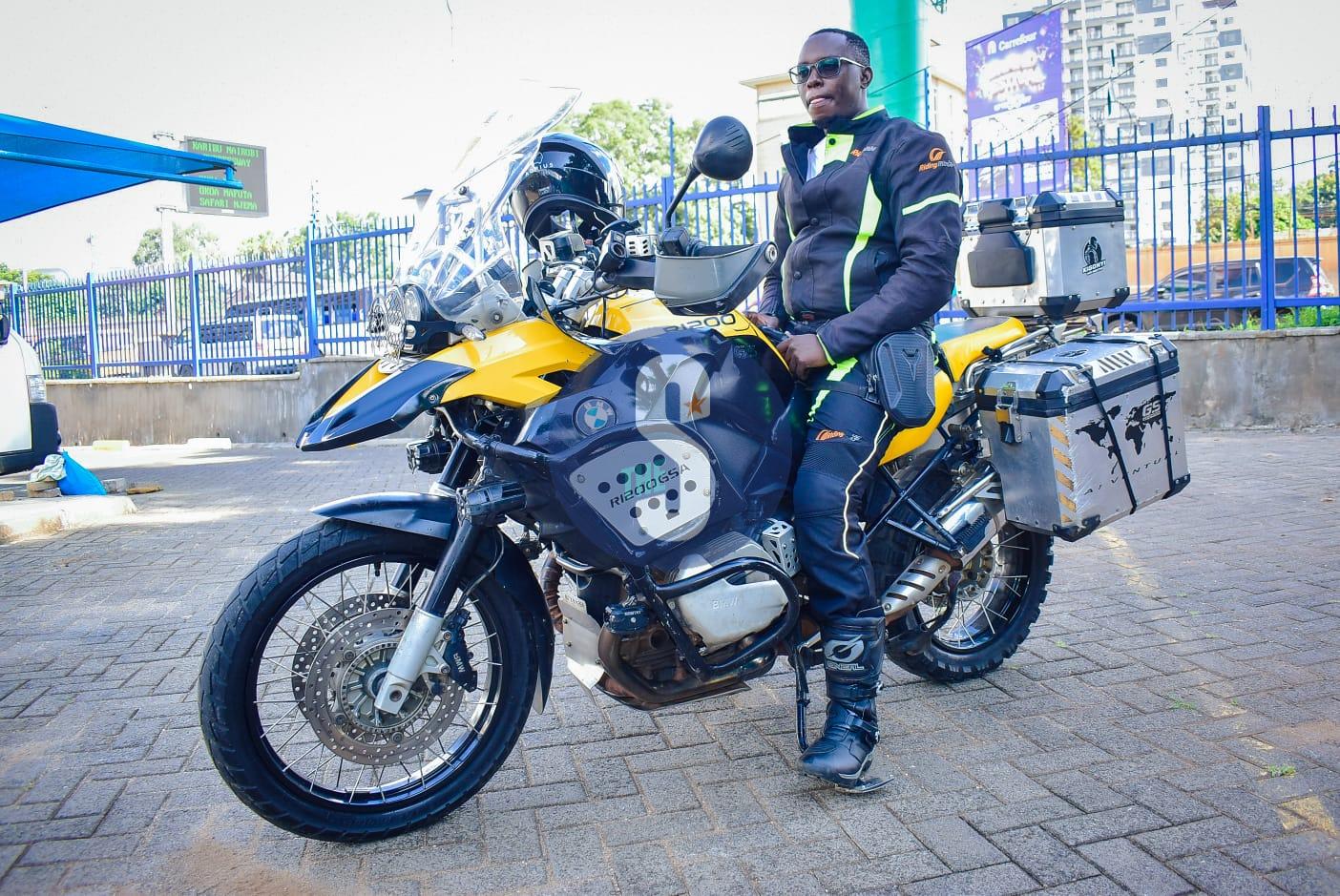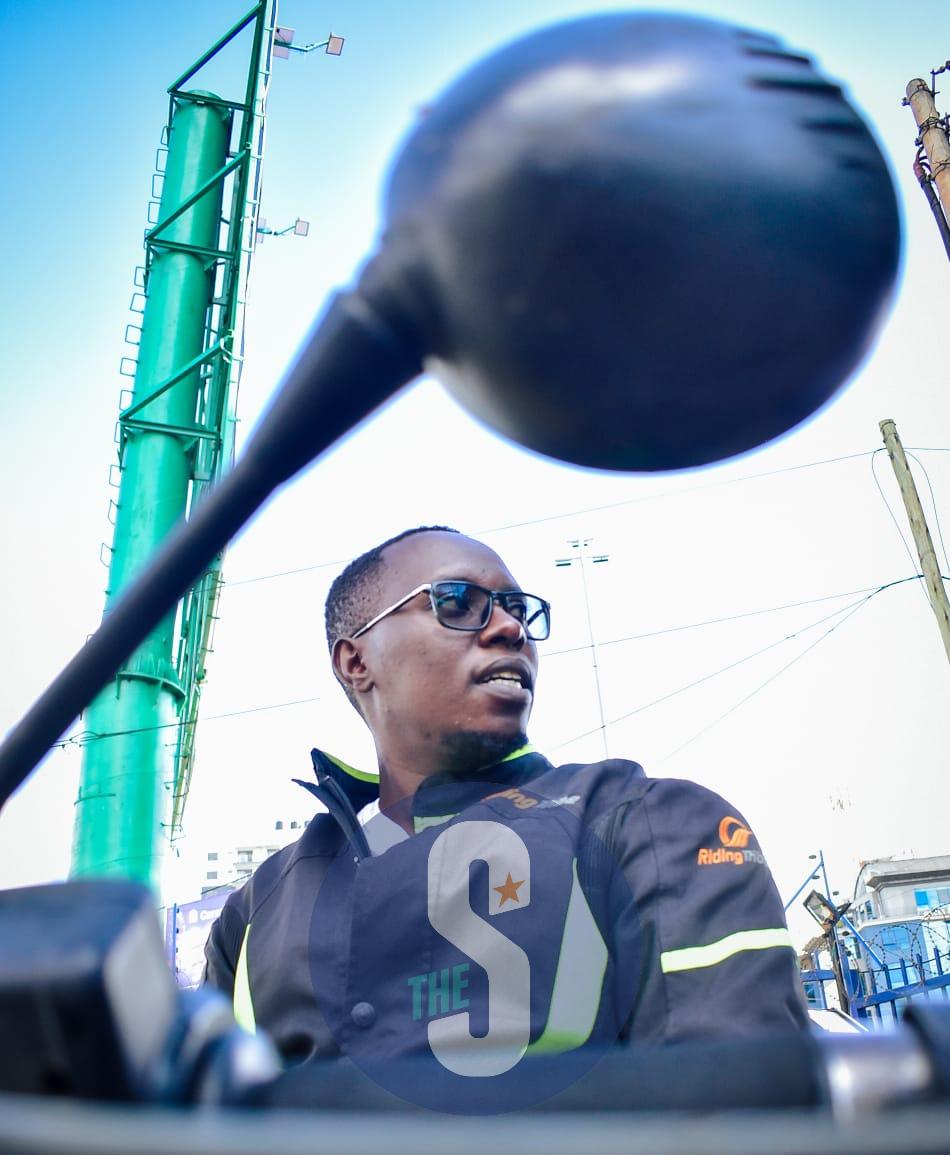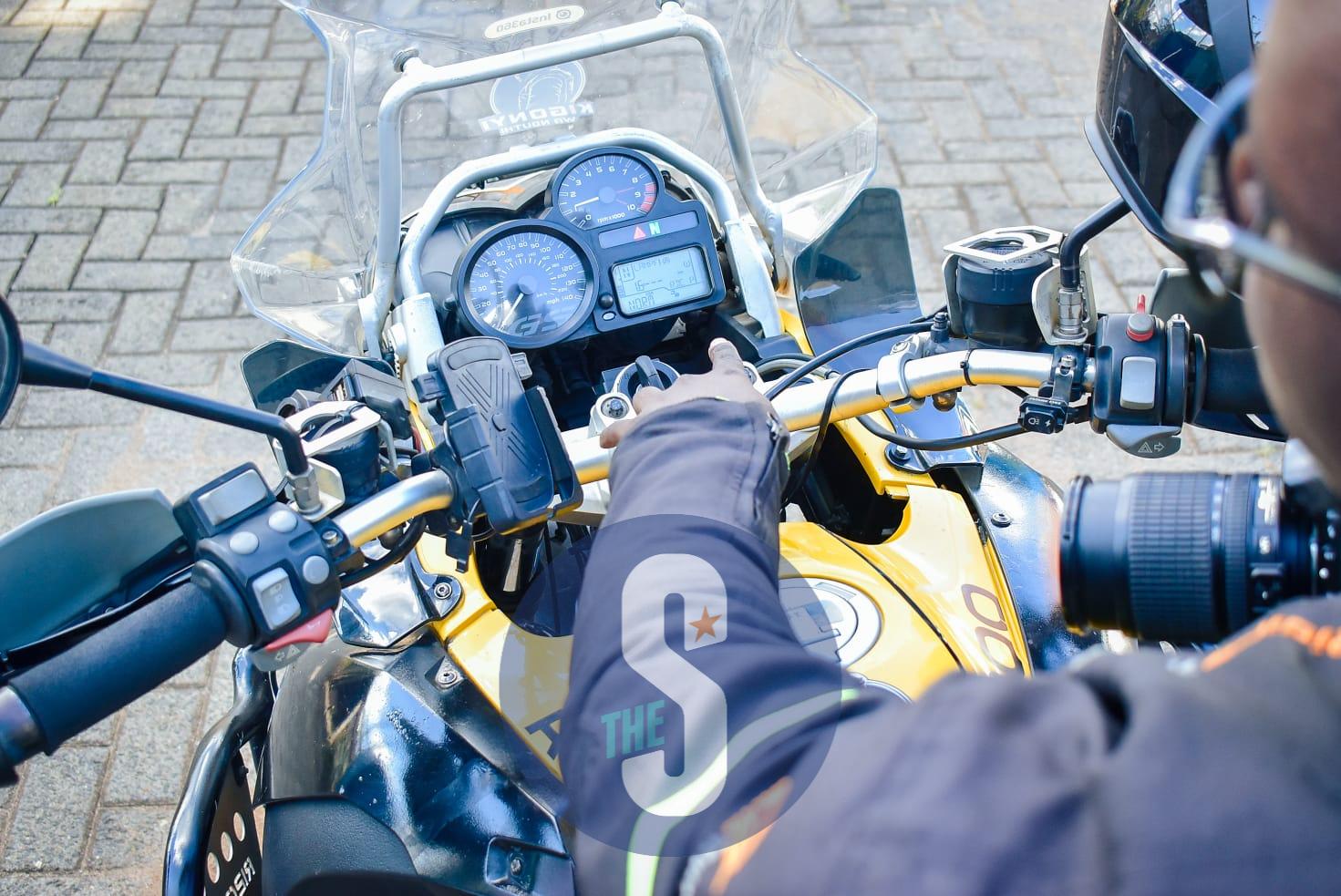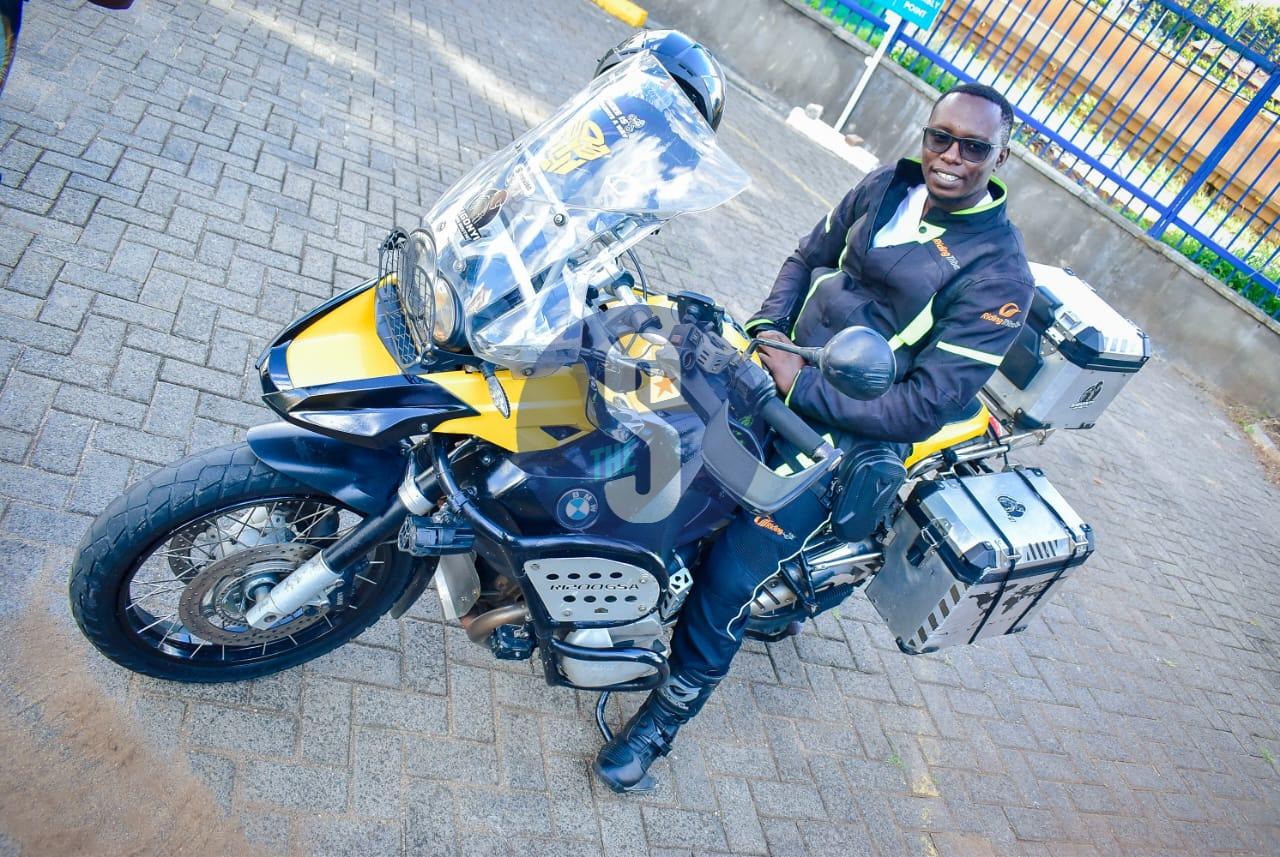
 Adventure biker Rex Maina, aka Kigonyi wa Nduthi on his BMW GS1200/PHOTO:VICTOR IMBOTO
Adventure biker Rex Maina, aka Kigonyi wa Nduthi on his BMW GS1200/PHOTO:VICTOR IMBOTOFor Rex Maina, popularly known as Kigonyi wa Nduthi, freedom doesn't come wrapped in four wheels or framed by the walls of a studio—it roars to life on two wheels, camera slung over his back, tyres spitting dust down unbeaten paths.
A self-taught photographer with a rebel’s heart and a biker’s soul, Kigonyi has turned Kenya’s roads, hills, and alleyways into both his canvas and his escape route.
His journey began not as a calculated career move but as a love affair with motion—fueled by curiosity, solitude, and the raw beauty of everyday life.
With every ride on his 400 kg BMW GS1200, which he fondly calls "The Bumble Bee," Kigonyi captures a side of Kenya few take time to see: the quiet dignity of roadside traders, the rustling hush of dawn-lit forests, and the poetry of poverty and joy intertwined.
His lens is unfiltered, his subjects unposed. This isn’t about picture-perfect landscapes—it’s about truth in motion.
In this Q&A, Kigonyi opens up about how biking shaped his artistic voice, the risks he takes for the perfect shot, and why the road—dusty, dangerous, and dazzling—is the only place he truly feels free while he advocates for safer traffic policies to accommodate the ever-evolving biking community in Kenya.
 Adventure biker Rex Maina, aka Kigonyi wa Nduthi on his BMW GS1200/PHOTO: VICTOR IMBOTO
Adventure biker Rex Maina, aka Kigonyi wa Nduthi on his BMW GS1200/PHOTO: VICTOR IMBOTOFor him, photography and adventure biking aren't a job. It’s a ride toward selfhood, one frame at a time, and one less biker accident.
Q: What was your first bike, and how did you get into riding?
A: My first ever bike was a Bajaj Boxer—Generation One with four gears. I actually didn’t buy it for passion or riding; it was strictly for business deliveries from point A to B. But I’m also a photographer and videographer who loves to travel. So over time, I started joining overlanding trips with big trucks and groups, primarily to take pictures.
Q: What exactly is overlanding?
A: It’s when you travel in off-road vehicles—like modified trucks or buses—through rugged terrain for adventure.
For example, we’d go on trips to places like Magadi. I wasn’t there as a traveler; I was there to capture the journey through photography.
Q: So that’s when your love for biking started?
A: Exactly. On these trips, I’d often feel limited. People would stop at certain points, I’d capture the first shot, but I knew if we waited ten more minutes, I could get something magical. But they’d be ready to move on.
I realised I needed my own means of transport to keep up and move freely. That’s when I started looking into getting a bike suitable for off-road photography adventures.
Q: And your first "real" adventure bike?
A: I went online and found a used Honda XR 125 bought from a KPLC auction—that was my first bike.
I’d done my research and knew it could handle off-road terrain well because part of my adventures were not on the highway.
Would you like us to tell your story related to this topic? If yes, please send details to [email protected]
Q: You mentioned the GS Adventure bike—what’s your experience with it?
A: Yes, I’ve actually ridden a few models. My bike is from an earlier generation, before they made some significant upgrades.
They added new riding modes and rebranded it as the 2015 version.
More recently, I was involved in unveiling the latest model—the BMW GS 1300 Adventure. It’s featured on my YouTube channel, actually.
Q: What’s new in the GS 1300 compared to the older models?
A: Quite a lot! While the older 1200 series was already a beast—comparable in size to a small car like a Morris—the 1300 was redesigned to be lighter, more compact, yet more powerful.
That’s crucial, especially for female riders or anyone intimidated by bulkier bikes.
 The dashboard of Adventure biker Rex Maina, aka Kigonyi wa Nduthi BMW GS1200/ PHOTO: VICTOR IMBOTO
The dashboard of Adventure biker Rex Maina, aka Kigonyi wa Nduthi BMW GS1200/ PHOTO: VICTOR IMBOTOMost of the challenge in handling these machines is psychological, not physical. So BMW focused on making the 1300 more approachable without sacrificing performance.
 Adventure biker, Rex Maina aka Kigonyi wa Nduthi on his BMW GS1200/PHOTO: VICTOR IMBOTO
Adventure biker, Rex Maina aka Kigonyi wa Nduthi on his BMW GS1200/PHOTO: VICTOR IMBOTOIt wasn’t about joining the hype; it was purely functional, solving my problem of mobility and freedom in photography.
Q: Which are your favorite biking routes in Kenya?
A: Hands down, the route from West Pokot, Kapenguria, and all the way to Kakuma. The landscapes are out of this world. I was there a few weeks ago and was amazed by the road infrastructure—it’s significantly improved since 2021.
It has the best landscapes, and it is the most scenic I have ever seen with less traffic.
The scenery is untouched, and traffic is minimal, making it a dream for photographers and adventure bikers.
Another one I’d recommend is the stretch from Voi to Taveta to the Kenya-Tanzania border at Tarakea. It's scenic, smooth, and also relatively traffic-free.
Professionally now as a photographer, from the word go for me, biking is an avenue to explore and document, and my company (Artist Media) believes in greatness in people and places to showcase the beauty of our country.
Q: Do you prefer adventure bikes over superbikes?
A: Absolutely. Adventure bikes are built for comfort and long-distance travel. Unlike superbikes—designed for speed and track racing—adventure bikes let you sit upright, which is ideal for covering many kilometers.
Brands like BMW even include comfort modes, heated seats, and various riding options to make the experience better.
Q: How vibrant is the adventure biking community in Kenya?
A: Very vibrant, especially recently. Initially, the Kenyan biking scene was dominated by sport bikes—people leaning into corners, flashy rides like the Kawasaki ZX series. But now, more people are drawn to adventure riding because it offers more than just commuting—it’s about exploring and you're doing so many kilometres.
There are standout riders too, like the godfather of biking in Africa, Abdi Zella. He’s written a book called Africa on Two Wheels and has ridden not only across Africa but globally—Asia, Kenya to South Africa, you name it.
He is the go-to guy if you want to go by bike through the Kenya-South Africa route.
He’s mentored a lot of newer riders, including Mustafa, who I recently featured on my YouTube channel.
Zella has mentored many beyond East Africa, and he used to ride with the GS 1250.
Q: Are there specific clubs or communities for adventure bikers?
A: Definitely. There’s a WhatsApp group called "Adventure Motorcycle" that even includes international riders. Locally, we have meetups for events like Koroma every weekend where we share stories, routes, and plans.
On Facebook, there’s “Africa Motorcycle Diaries,” one of the most active biking groups on the continent, with nearly 180,000 members.
People post about their rides, share routes, and organise trips together. It’s a real family vibe. These are clubs anyone can join, and there is no fee. As long as you are riding, you are family.
Q: What challenges do Kenyan riders face, especially adventure bikers?
A: Several. First, road conditions. Some potholes and open manholes are downright deadly.
I hit one recently near Chaka Place in the middle of the night, and it stalled my bike, even though it’s an off-roader. If I had been on a sportbike, it could’ve been fatal.
Then there’s the issue of excessive speed bumps. One of our mentors once counted 700 bumps between Nairobi and Malaba.
Compare that to a similar stretch in a desert—less than 10! It’s absurd and shows lack of consideration in road design.
Q: What about policy and public perception of bikers?
A: That’s another major issue. Riders are rarely included in policy discussions, despite our growing numbers.
Nairobi alone has a massive biking population, yet we lack basic infrastructure like drop zones or designated parking.
Also, the current parking policy is flawed. Riders have to pay monthly for parking—even if they only come into the CBD twice a month—and still struggle to find space.
Q: Do you think public perception plays a role in poor policies?
A: Absolutely. Many people see riders as reckless, always overtaking, ignoring rules.
That fuels negative stereotypes. But I always say: it’s a two-way street. Riders need to be more disciplined too.
Some get bikes without even having valid licenses. It only comes to light after an accident, and then everyone is scrambling to hide the evidence.
Q: So what’s the way forward?
A: I believe in creating a bridge between bikers and policymakers.
Through content creation and advocacy, I try to raise awareness on both sides.
We need infrastructure, policies, and respect. But we also need to police ourselves and hold each other accountable.
Biking, for me, started as a way to solve a personal problem. Now, it’s grown into a lifestyle, a career shift, and a mission.
Through it, I’m telling stories, showcasing Kenya, and pushing for change.
For more on Rex Maina, aka Kigonyi Wa Nduthi adventures, follow him on the following social media handles:
Twitter: @rex_maina
Youtube: Kigonyi Wa Nduthi
Instagram: @REXMAINA
Facebook: REX MAINA
Tik Tok: kigonyiwanduthi
Would you like us to tell your story related to this topic? If yes, please send details to [email protected]












